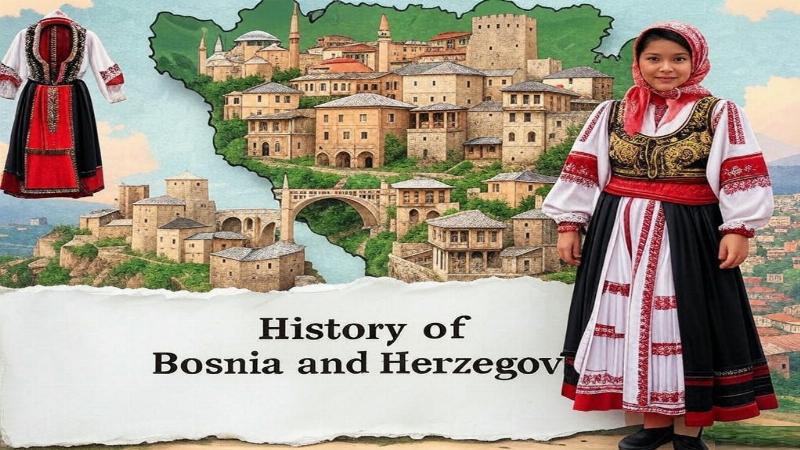Place for ads

Bosnia and Herzegovina, a heart-shaped nation in the Balkans, is a land where history weaves through its rugged mountains and river valleys. Covering 51,129 square kilometers, it lies between Croatia, Serbia, and Montenegro, its diverse peoples reflecting centuries of cultural fusion. Known today for its resilience and scenic beauty, Bosnia and Herzegovina’s past is a complex tale of ancient tribes, imperial rule, and modern conflict. In this article, we’ll trace its journey from its earliest days to its contemporary identity, uncovering the milestones that have shaped this enduring country.
The history of Bosnia and Herzegovina begins around 40,000 BCE, with Paleolithic hunter-gatherers leaving tools in caves like Badanj near Stolac—rock engravings there depict hunting scenes. By 4000 BCE, Neolithic farmers settled the Drina and Bosna river valleys, growing wheat and crafting pottery, as seen at Butmir near Sarajevo.
The Bronze Age (2000 BCE) brought Indo-European tribes, ancestors of the Illyrians, who mined copper in the Dinaric Alps. Iron Age hill forts—like those at Glasinac—show a warrior society by 1000 BCE, trading with Greeks and Celts. These early peoples laid the ethnic roots for Bosnia’s future diversity.
By 400 BCE, the Illyrians
Place for ads
Rome’s fall in the 5th century CE left Bosnia vulnerable—Goths and Avars raided, but Slavic tribes arrived by the 7th century, blending with Illyrians. Christianity spread, with early churches like those in Zenica, setting a spiritual stage for medieval kingdoms.
By the 10th century, Bosnia emerged as a distinct entity under Slavic rule, tied to Croatia or Serbia at times. The 12th-century Banate of Bosnia, led by figures like Ban Kulin, gained autonomy—his 1189 charter with Dubrovnik is Bosnia’s oldest document. The Bosnian Church, a unique Christian sect, flourished, defying Rome and Constantinople.
The 14th century saw the Kingdom of Bosnia peak under King Tvrtko I (1353–1391), who crowned himself in 1377, stretching from the Adriatic to the Sava River. Castles like Jajce and stećci tombstones—UNESCO-listed—mark this golden age. Ottoman conquest in 1463 ended independence, ushering in a new era.
The Ottomans transformed Bosnia—Sarajevo, founded in the 15th century, became a trade hub with its Gazi Husrev-beg Mosque. Islam spread, especially among elites, creating a Bosniak Muslim identity, while Catholics and Orthodox Christians persisted. Mostar’s Old Bridge, built in 1566, symbolized Ottoman engineering.
Bosnia thrived as a frontier province—janissaries guarded borders, and crafts like metalwork boomed. Yet, heavy taxes sparked revolts—like Husein Gradaščević’s 1831 uprising—demanding autonomy. The 1875 peasant rebellion signaled Ottoman decline, paving the way for European intervention.
The 1878 Congress of Berlin handed Bosnia to Austria-Hungary, ending Ottoman rule. Vienna modernized—railways, schools, and factories rose—but Bosniaks, Serbs, and Croats chafed under foreign control. Sarajevo’s 1908 annexation fueled unrest, culminating in 1914 when Gavrilo Princip assassinated Archduke Franz Ferdinand, igniting World War I.
The war devastated Bosnia—tens of thousands died, and Austria-Hungary collapsed in 1918. Bosnia joined the Kingdom of Serbs, Croats, and Slovenes (later Yugoslavia), but ethnic tensions simmered—Serb dominance alienated Bosniaks and Croats, setting a fragile stage.
In Yugoslavia, Bosnia was a multiethnic core—Sarajevo hosted industries, while rural life clung to tradition. World War II shattered this—Nazi-aligned Croatian Ustaše massacred Serbs and Jews, while Tito’s Partisans fought back, liberating Bosnia by 1945. Over 300,000 died, but victory birthed socialist Yugoslavia.
Tito’s era (1945–1980) rebuilt Bosnia—steelworks in Zenica and hydropower thrived, blending Bosniak, Serb, and Croat identities under communism. The 1984 Sarajevo Winter Olympics showcased progress, but Tito’s 1980 death unleashed nationalism—Slobodan Milošević’s rise in Serbia signaled trouble.
In 1992, Bosnia and Herzegovina declared independence from Yugoslavia after a referendum—Serbs boycotted, wanting to join Serbia. War erupted—Bosnian Serb forces, backed by Belgrade, besieged Sarajevo for 1,425 days, killing 11,000. Srebrenica’s 1995 massacre—8,000 Bosniak men and boys slain—marked the conflict’s horror.
The 1995 Dayton Agreement ended the war, splitting Bosnia into the Federation (Bosniak-Croat) and Republika Srpska (Serb), under a weak central government. Over 100,000 died, 2 million fled—peace held, but scars lingered, with ethnic divides etched into politics.
Today, Bosnia and Herzegovina’s 3.5 million people rebuild—Sarajevo’s Baščaršija buzzes again, Mostar’s bridge was restored in 2004. Tourism and energy drive growth, but unemployment and corruption stall progress. The tripartite presidency—Bosniak, Serb, Croat—struggles, with Republika Srpska eyeing secession.
Culture thrives—Sevdah music, Bosnian coffee, and films like “No Man’s Land” reflect resilience. EU aspirations falter, but youth seek unity—Sarajevo’s 2019 film festival bridged divides. Bosnia balances its past with a fragile hope for harmony.
Bosnia and Herzegovina’s history is a Balkan epic—from Illyrian forts to Ottoman minarets, war’s ashes to peace’s dawn. Its rivers carry tales of strife and strength. As Bosnia strides forward, its past fuels a legacy of survival and soul.
Place for ads